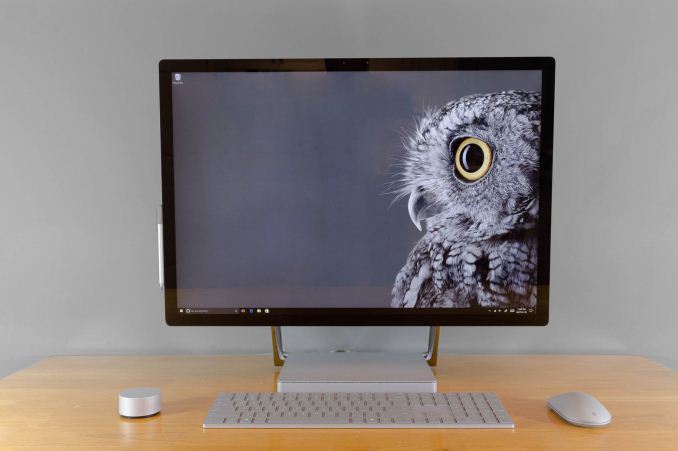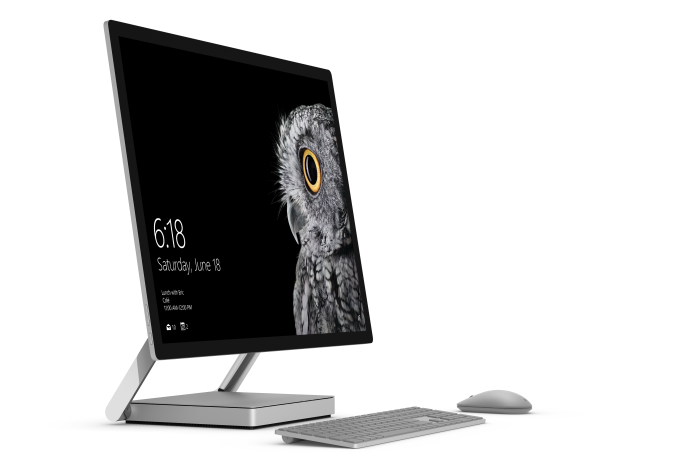The Microsoft Surface Studio Review
by Brett Howse on January 20, 2017 8:00 AM EST- Posted in
- Desktop
- Microsoft
- Surface
- Surface Studio

Microsoft has only been in the PC system game for a few years now, but over the last couple of years they have made a lot of progress rather quickly. These days they have a solid foundation of products available, with the Surface Pro 4 being one of the best convertible tablets, the Surface Book being a very solid convertible laptop, and also the more specialized products like the Hololens, and Surface Hub. Going into their October 2016 event, the one missing piece of their PC product lineup was a desktop computer, but with the announcement and release of the Surface Studio, that particular gap has now been filled.
But the Surface Studio is not your typical desktop PC. Even at first glance, the sleek, beautiful lines are readily apparent, and once powered on, it is rare for anyone to first glimpse the 28.125-inch 4500x3000 display and not say “wow”. It’s not only the very high resolution, but also the 3:2 aspect ratio that is unheard of in this segment, that makes the display stand out as something unique.
Microsoft has become one of the superlative hardware manufacturers in only the short span of four years or so, and the Surface Studio is one of their finest designs yet. However, from the very first Surface RT, Microsoft always tries to add something different, but more importantly interesting, to their designs, and in the case of the Surface Studio, it is the zero-gravity hinge, which allows the all-in-one to be quickly and easily tilted back to a 20° angle, letting it be used as a huge, digital drafting table. Microsoft announced the Surface Studio at their October Windows event, where they also announced the next Windows 10 Update, called the Creator’s Update, and it is wonderful to see them building hardware to truly bring out the exclusive features of their software.
Packed into the base of the Surface Studio is a laptop-class computer, with three different models available now. The base model, coming in at $2999, features an Intel Core i5-6440HQ processor, 8 GB of memory, a 1 TB hybrid drive with a 64 GB SSD cache, and a NVIDIA GeForce GTX 965M GPU. The mid-level model, which costs $3499, bumps the CPU up to an Intel Core i7-6820HQ, doubles the RAM to 16 GB, and doubles the SSD cache to a PCIe 128 GB model, with the same 1 TB HDD and GTX 965M. The highest priced model, at $4199, is an Intel Core i7-6820HQ, 32 GB of RAM, a 2 TB hybrid drive with a 128 GB PCIe cache, and a NVIDIA GTX 980M GPU with 4 GB of memory.
| Microsoft Surface Studio | ||||||
| Base | Middle | Top (As Tested) | ||||
| CPU | Intel Core i5-6440HQ Quad-Core, 2.6-3.5 GHz 6 MB Cache, 45W TDP, No Hyperthreading |
Intel Core i7-6820HQ Quad-Core, 2.7-3.6 GHz 8 MB Cache, 45W TDP, Hyperthreading |
||||
| GPU | NVIDIA GTX 965M 1024 CUDA Cores 944 Mhz + Boost 2 GB GDDR5 128-bit memory |
NVIDIA GTX 980M 1536 CUDA Cores 1038 Mhz + Boost 4 GB GDDR5 256-bit memory |
||||
| RAM | 8 GB DDR4 | 16 GB DDR4 | 32 GB DDR4 | |||
| Storage | 1 TB Hybrid Drive 64 GB SATA SSD Cache / 1 TB SATA HDD |
1 TB Hybrid Drive 128 GB PCIe SSD Cache / 1 TB SATA HDD |
2 TB Hybrid Drive 128 GB PCIe SSD Cache / 2 TB SATA HDD |
|||
| IO | 4 USB 3.0 ports - one high power port Full size SD Card Slot Headset Jack Xbox Wireless Connectivity DisplayPort |
|||||
| Display | 28.125-inch PixelSense Display 4500 x 3000 resolution 192 DPI sRGB, DCI-P3, P3 D65 color modes |
|||||
| Webcam | 5 MP Webcam Windows Hello Facial Recognition |
|||||
| Networking | Marvel AVASTAR 802.11ac Intel I219-LM Gigabit Ethernet |
|||||
| Price | $2,999 | $3,499 | $4,199 | |||
There was quite a bit of discussion at the time of the Surface Studio launch over the fact that it was equipped with older technology. Intel’s Kaby Lake quad-core parts just launched at CES this year, so Skylake quad-core CPUs were the latest generation available at launch. The Maxwell based graphics options chosen were not the latest generation mobile graphics from NVIDIA, with the GTX 965M and GTX 980M available in the Studio. The Pascal based GTX 1060 and GTX 1070 would have been much more powerful substitutes, but they are not pin-compatible drop-in components with the Maxwell GPUs in the Surface Studio, meaning a new board design and thermal considerations would have been necessary late in the design phase, and Microsoft appears to have been conservative here to avoid missing their launch window.
Microsoft has also been very conservative with their I/O choices, with four USB 3.0 Type-A ports on the back of the Studio, along with a SD card slot, and mini DisplayPort. As with the Surface Pro 4 and Surface Book, Microsoft has continued to provide only the older USB-A ports, and not even offer a single USB-C port, let alone with Thunderbolt. Anyone purchasing a Studio will likely be using it for several years, and the lack of USB-C is going to be an issue in the future, if not already today. The Surface team really needs to reconsider this as it is already a detriment to not include any.
There also must be some questions raised about the use of a hybrid drive in a PC of this price. We’ll dig in to the experience later, but Microsoft could and should offer a larger SSD as the boot disk, complimented by a HDD as a secondary disk, at least on the highest end model. A 512 GB NVMe SSD as the boot drive would appease much of the criticism. The computer does cost over $4000 after all, and while much of the cost of the device is in the display, SSDs have been the biggest improvement in user experience on the PC in a long time.











197 Comments
View All Comments
hoohoo - Sunday, January 29, 2017 - link
It is very nice but the price as tested is completely ridiulous.It is essentially a high spec laptop packaged in a big screen. If Asus os such were to step up it could offer the same thing for half the price.
Septillion - Wednesday, February 1, 2017 - link
So the vivid color profile aka P3 D65, is practically identical to Apple's Display P3 color profile? Same P3 primaries, D65 white point and 2.2 gamma.darwinosx - Sunday, February 5, 2017 - link
I use a Mac laptop at work and also have one at home. We have a lot of pro-Microsoft people at work including my boss who is the VP of software development. We also are working closely with Microsoft on a major project. Many of the people I work with got a Surface Pro 4 thinking they would really lie it but all of them are sick of all the issues and the service desk finally stopped allowing them because of all the issues. Several of the developers, including my boss, have Mac laptops on order now.lcf/bill - Thursday, February 9, 2017 - link
Nice to see a timely review of a product.At this point, it is looking like the Touch Bar Macbook Pro review may not be out before the hardware is revised.
IamDavid - Saturday, February 11, 2017 - link
I want to purchase the top level version but I need the ability to connect the audio to my Home Theater system. I only see a 3.5mm audio port so I assume at best I'd have stereo? Any options for have full HD audio out?macmhathain - Saturday, June 17, 2017 - link
I find this product fascinating. I'm not sure I agree that Microsoft tries to add something interesting in every computer since the Surface - they add touch to desktop PC - Suface, Surface Pro, Surface Book, Surface Laptop, and Surface studio. But, he addition of touch to a desktop PC does some very interesting things which are natural outgrowth of touch - 2 in 1 with detachable keyboard, UI that switches between desktop and tablet mode, pen support. All of these are natural outgrowths of the decision to put touch on desktops. The problem is that comes with trade-offs. The most important is cost. the Surface studio is $4000 - that would pay for an amaizngly speced out Mac or and an epically speced out traditional PC. I have heard the surface studio is slow (I don't own one but have played with it in store and based on Leo Leports comments) but what one would expect from the hardware that powers that screen (and the decision to put it into a tiny box). My wife is a professional photographer - and she really needs power in her computer. the size of her imports, running lightroom, photoshop, and a brower continually and switching between them need a powerful computer not to be slow. So the surface studio, even if it would be awesome for the occasional very precise artistic edit, wouldn't work well for the day to day grind of a photographer - and I expect the dame problem for a video editor, or graphic designer would have the same problems with lack of power. Why not attach that amazing screen to a giant box filled with i7s a ton of fast RAM and a huge SSD and a bunch of fans? sure it would cost a lot more like $10,000 - but it would do the job it is supposed to do well, unlike now where it is crippled by a trade off for aesthetics and to keep the price low (you could put at least a few better parts in the little box like a great SSD which would have helped and kept the aesthetics). I am fasciated to see who will be right. Microsoft with desktop computers need touch, or Mac that desktops needs mouse and keyboard and touch based "tablets (although a 27" ipad would be an interesting device for photo editing if it were fast enough and had enough storage)" are the only things that have touch. For me buying a computer in exchange for the additional cost for the touch screen, I'd rather have that money spent on more RAM or a better CPU or a faster SSD.Danilushka - Saturday, April 7, 2018 - link
Such a shame: Microsoft takes an innovative leap past Apple but snatched defeat from the jaws of victory sabotaged by it's buggy unreliable aged Windows operating system and poor quality control.No wonder Apple isn't rushing out large touchscreens: the competition just cannot deliver on them.
Unfortunate because competition keeps vendors innovating.